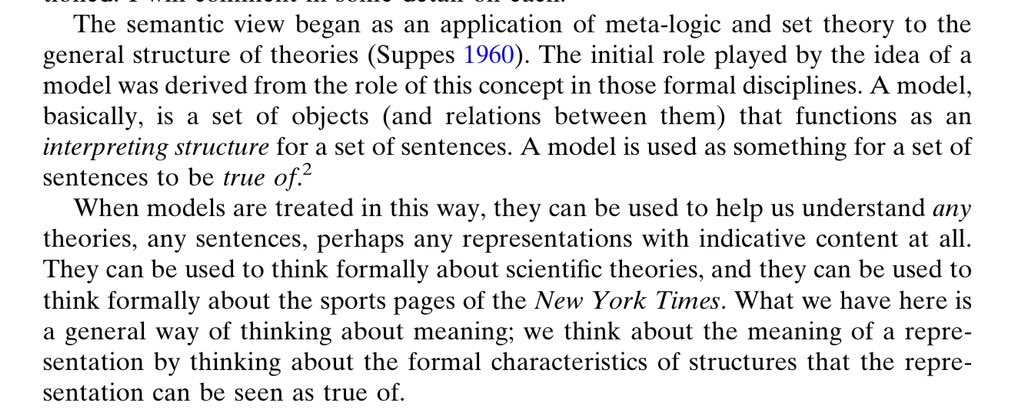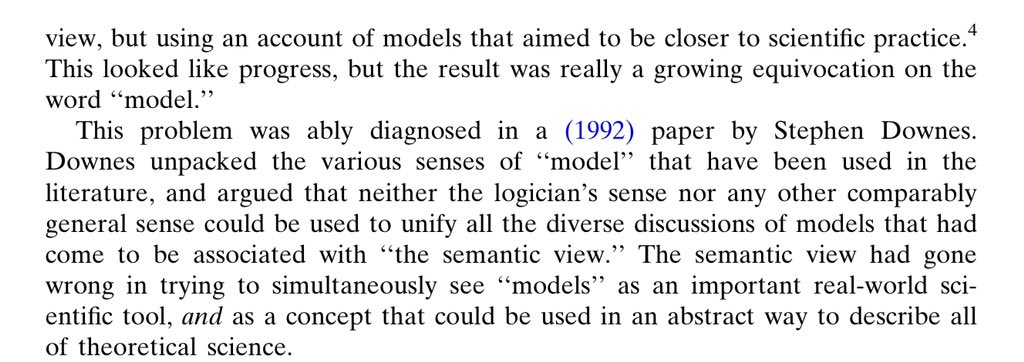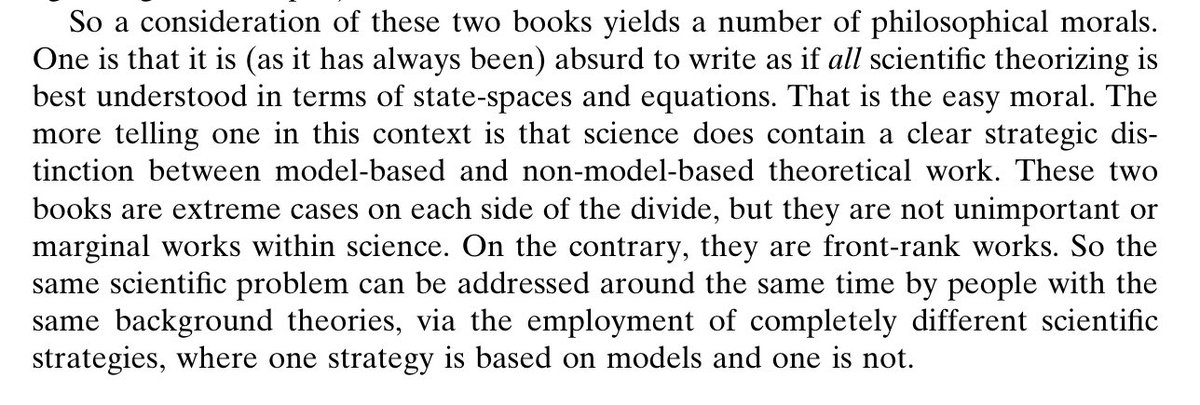Reading Godfrey-Smith’s (2006) The Strategy of model-based science. Similar to Weisberg (whose ‘Who is a modeler?’ I tweeted about yesterday), GS treats models and model-building as characteristic of one particular approach to theorizing. https://www.petergodfreysmith.com/PGS-StrategyMBS-06.pdf">https://www.petergodfreysmith.com/PGS-Strat...
GS uses Giere as a starting point: “models are idealized structures that we use to represent the world, via resemblance relations between the model and real-world target systems.” Admittedly, this itself is an idealized model of some type of science.
The modeler’s strategy is to gain understanding of a complex real-world system via an understanding of simpler, hypothetical system that resembles it in relevant respects.
GS’s analysis of model-based science does not subscribe to the semantic view of theories which has these two ideas at the center. GS rejects both of them.
Against the background given below, GS’s analysis of model-based science is intended to be neither ‘‘semantic’’ (in the sense of drawing on model theory) nor a ‘‘view of (all) theories.’’
GS views model-based science as an approach to representing & understanding the world w psychological, sociological, formal features (vs. a kind of cognitive change). He aims to show there is a genuine phenomenon, a ‘‘natural kind’’ w/in the larger domain of theoretical science.
In some contexts, strategy of modeling shows up in its pure form. “What we see in those cases may be the scientific elaboration and formalization of a more general and psycho- logically deep capacity for model-based understanding.” —one of many capacities for theoretical science.
“In much scientific theorizing, we may find a complex mixture, or a to-and-fro movement, between the strategy of modeling and other, more ‘‘direct’’ approaches to representing and understanding the world.”
Reminds me of Chang’s epistemic iteration. https://twitter.com/zerdeve/status/1279227684111835136">https://twitter.com/zerdeve/s...
Reminds me of Chang’s epistemic iteration. https://twitter.com/zerdeve/status/1279227684111835136">https://twitter.com/zerdeve/s...
GS also talks about a recognizable style of model-based science (self-conscious or not) that has been increasing in prominence within science, on a decade-long and perhaps centuries- long time-scale. A style guided by its own distinctive set of ideals.
To be contrasted with model-based strategy are approaches that avoid any deliberate detour through merely hypothetical systems, and seek to directly represent the workings of the real-world system we are trying to understand. What Weisberg refers to as ADR  https://abs.twimg.com/emoji/v2/... draggable="false" alt="👇🏼" title="Rückhand Zeigefinger nach unten (mittelheller Hautton)" aria-label="Emoji: Rückhand Zeigefinger nach unten (mittelheller Hautton)"> https://twitter.com/zerdeve/status/1331408149539028993">https://twitter.com/zerdeve/s...
https://abs.twimg.com/emoji/v2/... draggable="false" alt="👇🏼" title="Rückhand Zeigefinger nach unten (mittelheller Hautton)" aria-label="Emoji: Rückhand Zeigefinger nach unten (mittelheller Hautton)"> https://twitter.com/zerdeve/status/1331408149539028993">https://twitter.com/zerdeve/s...
Almost in direct response to my question quoted above, GS wants to make clear the fact that treating all theorizing as involving models, in the style of the ‘‘semantic view,’’ is misguided.
Based on a case study of comparing two books on evolutionary theory with opposite approaches (Leo Buss’ The Evolution of Individuality, 1987 and Maynard Smith and Szathmáry ’s The Major Transitions in Evolution, 1995), GS makes two observations.
So when trying to understand a complex & unknown system, one approach is to try to identify & describe the actual system’s parts and their workings. A distinct approach is to deliberately describe another system, a simpler hypothetical system, and try to understand that first.
Still, it would be a mistake to say that the distinction is always so easy to draw. Scientists may move backwards and forwards between the two approaches very rapidly. They may insist that they are doing one thing when they seem to be doing the other.
>> This is accurate imho.
>> This is accurate imho.
A second challenge comes from the fact that work that appears to be of one kind can often be re-interpreted as work of the other kind. A person might take an attempted ‘‘direct’’ representation, and treat it as a model, for example.
One way in which an old scientific theory can be recovered is by recasting it as a model. Someone can take an old theory and treat it not as a failed direct description of reality, but as a specification of an interesting fictional system that can be studied in its own right.
The treatment of model systems as comprising imagined concrete things is the ‘‘folk ontology’’ of at least many scientific modelers. It is the ontology embodied in many scientists’ unreflective habits of talking about the objects of their study.
This view is to be taken seriously but it would be a mistake to apply it too strongly and uniformly. In areas where mathematical methods can be used, one part of the practice of modelers is to discuss mathematical objects and structures in their own right.
In these areas, what we often see is as a kind of oscillation between thinking of a model system in very concrete terms, and moving to a description of purely mathematical structure. It would be a mistake to insist that one of these is ‘‘the model’’ and the other is not.
Toward a conclusion:
Within model-based science, in the course of everyday work, much talk is about the model. Many of the hypotheses under discussion will be hypotheses about how model systems of various kinds behave.
Within model-based science, in the course of everyday work, much talk is about the model. Many of the hypotheses under discussion will be hypotheses about how model systems of various kinds behave.
When much day-to-day discussion is abt model systems, disagreement abt the nature of a target system is less able to impede communication. The model acts as a ‘‘buffer” enabling communication & cooperative work across scientists who have diff commitments about the target system.
Some interesting parallels here between GS’s observations for model-based science and our model of scientific process developed here. We deal with imaginary populations of scientists and switch back and forth btw treating them as such and treating them as mathematical objects. https://twitter.com/zerdeve/status/1128734143347445760">https://twitter.com/zerdeve/s...

 Read on Twitter
Read on Twitter







